It is worth looking upwards inside Villa 102. The historic villa’s ceilings are adorned with elaborate stucco.For master plasterer and restoration specialist Tilmann Breyer, it was a genuine pleasure to restore these masterpieces.
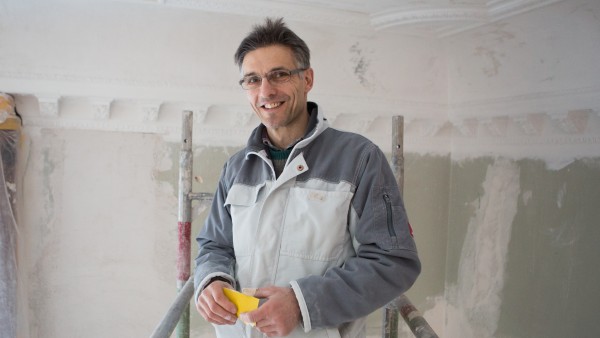
Spirited
Tilmann Breyer is a plasterer filled with passion. He calls Villa 102’s intricately-designed ceilings “true craftsmanship”.
Panelled ceilings with decorative mirrors, multi-faceted ornaments and opulently structured surfaces: the stucco ceilings in Villa 102 tell many stories about the riches of its builders and their good taste. “That is true craftsmanship, wonderful work, not just anyone could do this,” says Tilmann Breyer of the luxurious ceilings at Bockenheimer Landstrasse 102. He is convinced that each room in the house only really comes into its own in combination with its stucco ceilings as pieces of art: “Without the stucco work, the villa would be a very different one and would lose a significant part of the appeal it has today.”
The master stucco plasterer and restorer from Oberursel, near Frankfurt, is responsible for supplementing and refreshing the stucco in the cultural monument, the refurbishment of which is due to be completed this year. He is one of the few people who still knows how to do this type of historical work. He had already decided to avoid limiting himself to his profession's main activity — covering interior and exterior surfaces as extensively as possible with mortar — by the time he completed his apprenticeship at the Hembus painting and plaster workshop in Frankfurt in 1987. It specialises in preserving the heritage of the profession: “This work is fun for me, and I didn't simply want to plaster square metre after square metre of flat surfaces.” Breyer became a master plasterer in 1994, then continued his training in France and Venice, where he refined his technique.
His work is his passion. He has a delicate sense of traditional and artistic style elements, which is why he enjoys his work in the villa: “The condition of the stucco is good, and the style is very beautiful.” So he is happy to take responsibility for restoring the existing materials and closing the many holes that have been made for electrical wiring. An appreciation of art and creativity are necessary for his work. Many culturally and historically important buildings like the “Gesellschaftshaus Palmengarten” are blossoming anew today thanks to his help. He has also proved that he can meet modern standards with projects like the former “Stars” restaurant in the basement of the Messeturm trade fair tower.
The decorative form of stucco, which is usually made from a mixture of mortar, lime and plaster, traces filigree ornamentation along the walls, ceilings and domes with its sculptural shapes and has been one of the most important techniques used for designing interior spaces and facades since antiquity. However, use of this decorative form as seen in the villa almost completely disappeared from architecture in favour of more modern style just a few years after the building's completion. During the post-war period, it was even considered a distraction. In addition to changing tastes, the high costs associated with restoration were also a factor. There were numerous reports of stucco being knocked down at night throughout the 1960s and 1970s in particular in Frankfurt's Westend district. Illegal measures were used to create a reality in line with modern architectural perception. Luckily, several ceilings escaped this post-war vandalism and were “hidden” with dropped ceilings. In the high-ceilinged rooms of older buildings, a ceiling was often hung beneath the stucco ceiling. This led to some significant damage in some cases, but at least the original ceilings remained.
Read more under the gallery.
Elaborate
Stucco is usually made from a mixture of mortar, lime and plaster. Buildings have been decorated with it since antiquity.
Villa 102
More information and pictures of the extensive restoration of Villa 102 in our special.
Learn moreThis type of ceiling suspension only affected one old wooden ceiling in the villa; the stucco had always made its mark on people's perception of the upper-class villa. Before the detailed work could begin, however, the existing stucco pieces had to be elaborately cleaned by stripping old layers of paint away: “That was a lot of work, the oil paint really made things very tricky,” says Breyer. Then it was time for the work itself, finished to a high quality and in accordance with the specifications for protection of historical monuments. “The villa is not an everyday type of job.” In this case, a number of techniques had to be used.
For example, Breyer recreated missing or destroyed stucco in the workshop using stucco plaster. During this process, he spread the plaster mix out onto a table and pulled it into the desired shape using a custom-made template (using a pulling technique). Then the pieces were carefully built in and protected from factors that could affect them in the future. In other sections, he poured the stucco material into a negative mould that was based on the original and then added it once it had hardened (moulding, casting and fixing). He formed other elements directly on the masonry using the still-wet stucco plaster (application). Using something known as the “Rabbitz” technique presented a challenge in Villa 102. For this, he first created a metal supporting substructure and subsequently used it to apply the plastering mortar. Lastly, many sections required plastering and smoothing, which was specialised work, especially when it came to the curves and corners. All of the techniques have one thing in common: they require patience, concentration and skill if they are to be successful.
Using something known as the “Rabbitz” technique presented a challenge in Villa 102. For this, he first created a metal supporting substructure and subsequently used it to apply the plastering mortar. Lastly, many sections required plastering and smoothing, which was specialised work, especially when it came to the curves and corners. All of the techniques have one thing in common: they require patience, concentration and skill if they are to be successful.
Breyer will not be able to pass down his knowledge and skills due to a lack of people going into his profession: “It is very difficult to find trainees. No one wants to get their hands dirty anymore.” He can understand the dread, because working above head height is physically strenuous, often resulting in shoulder and neck problems: “As a stucco plasterer, I usually work against gravity, which leads to a forced, lopsided posture.” But his work makes him proud and happy: “I have a genuine desire to preserve old things and the passion and patience for Sisyphean work.” However, the associated satisfaction does not last long; Breyer acknowledges that he is already thinking about the next building site while he finishes the one he is working on. With his dedication to preserving historical structures, he will be able to look back at a “Gesamtkunstwerk” at the end of his career.
Published on KfW Stories: Monday, 17 September 2018

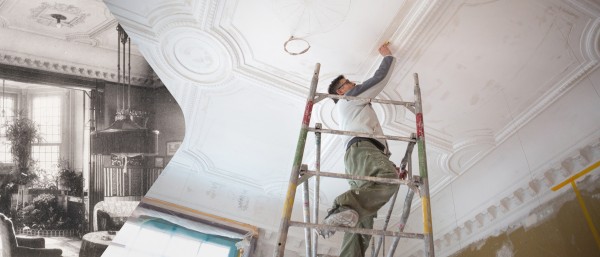
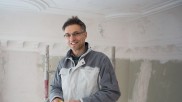
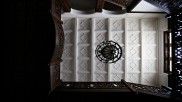
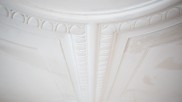
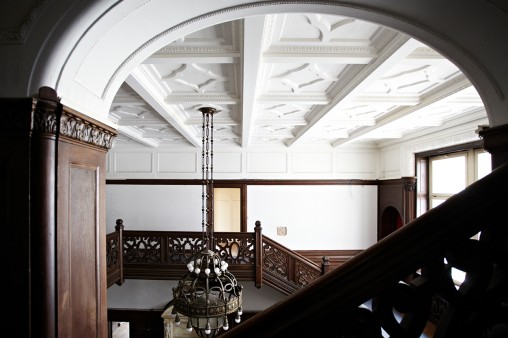
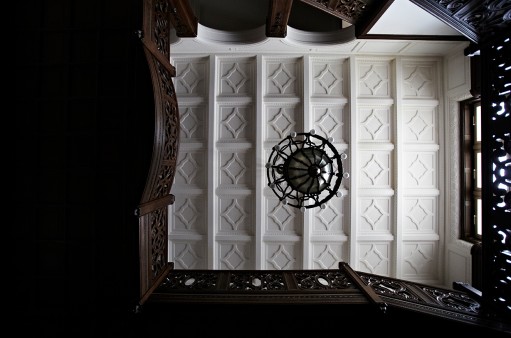
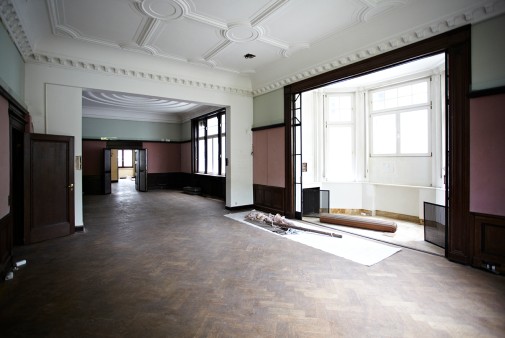



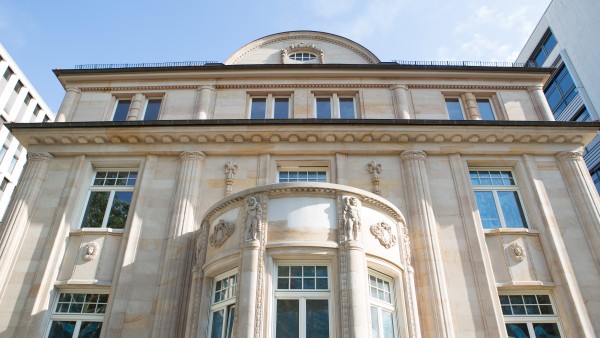
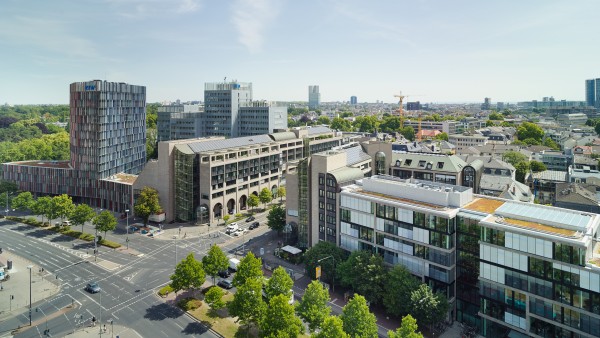

Data protection principles
If you click on one of the following icons, your data will be sent to the corresponding social network.
Privacy information